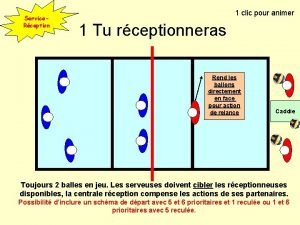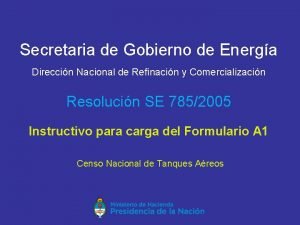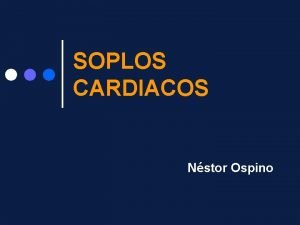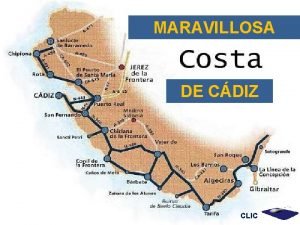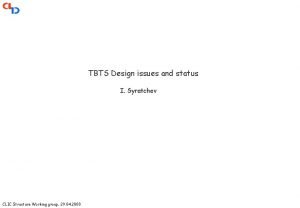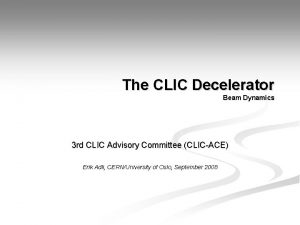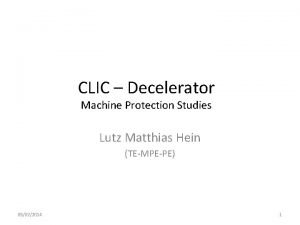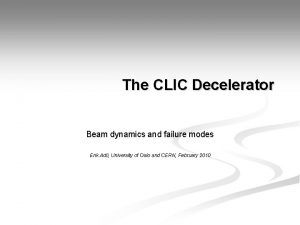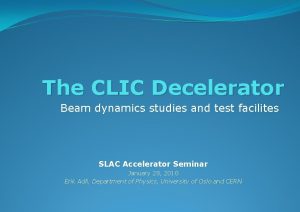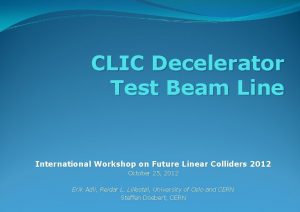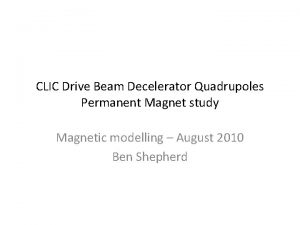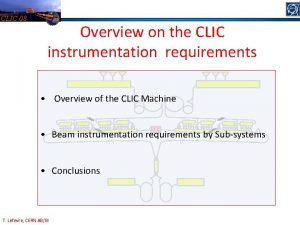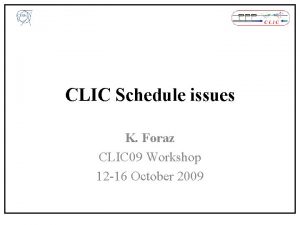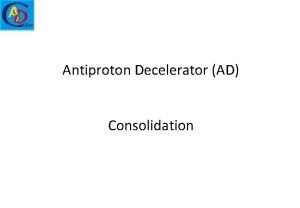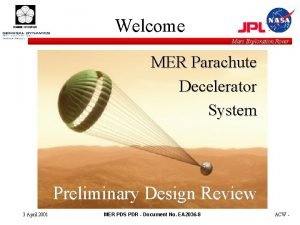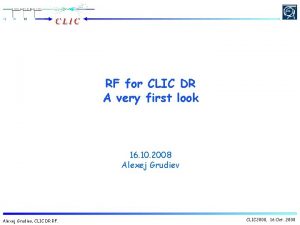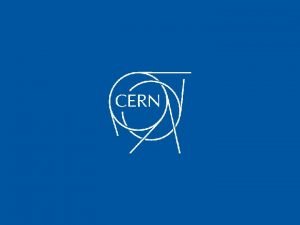The CLIC decelerator Instrumentation issues a first look









![Energy extraction efficiency: h n h=Pin/Pout : steady state power extraction eff. : h=P[W] Energy extraction efficiency: h n h=Pin/Pout : steady state power extraction eff. : h=P[W]](https://slidetodoc.com/presentation_image_h2/2f0864ae56649a9de168f0b2156e195a/image-10.jpg)













- Slides: 23

The CLIC decelerator Instrumentation issues – a first look E. Adli, CERN AB/ABP / Ui. O October 17, 2007

What are we talking about? The decelerator

Content n Particularities of the decelerator beam n Instrumentation discussion n Comparison with the TBL Goal of presentation: convey beam dynamics of the drive beam decelerator, then discuss (in plenum) the instrumentation issues

Part 1 Particularities of the decelerator beam

Decelerator BD requirements n Deliver required power to accelerating structures Minimize losses ( smaller than 0. 1% ) n High power production efficiency Low final energy large energy spread Our target is to transport the beam, the whole beam, through the decelerator lattice

The decelerator lattice (parameters of mid-2007) n 26 * 2 stations n 688 units per station

The CLIC drive beam n High-current, low-energy beam for strong wake field generation n Initial beam parameters: n E 0 2. 5 Ge. V n I 96 A n d = 25 mm (bunch spacing, fb = 12 GHz) n t 300 ns (3564 bunches) n Gaussian bunch, z 1 mm n e. N 150 mm 1 st particularity of the decelerator beam: huge current

Principle of power generation n Particles will feel parasitic loss and induce a wake field in the PETS The wake field will interact with and further decelerate : 1) rear part of bunch (single-bunch effect) 2) following bunches (multi-bunch effect) The integrated effect in a PETS on a witness particle due to a source particle is given by

Simulation results: energy extraction n PETS longitudinal wake parameters: n n R’/Q = 2295 W/m (linac-convention) f. L=11. 99 GHz bg = 0. 453 Beam energy profile after lattice: (initial: flat E =2. 5 Ge. V) 0 NB: leading particle always to the left! (PLACET output def. ) 2 nd particularity of the decelerator: huge energy spread
![Energy extraction efficiency h n hPinPout steady state power extraction eff hPW Energy extraction efficiency: h n h=Pin/Pout : steady state power extraction eff. : h=P[W]](https://slidetodoc.com/presentation_image_h2/2f0864ae56649a9de168f0b2156e195a/image-10.jpg)
Energy extraction efficiency: h n h=Pin/Pout : steady state power extraction eff. : h=P[W] N / E 0[e. V] I[A] n We can express the steady state extraction efficiency as: h = S F( ) hdist where for current CLIC parameters: n S = 90. 0 % (max energy spread) n h = S F( ) hdist = 90. 0 % 96. 9 % 97. 4 % =84. 5 % n (hdist can be improved with detuning: not discussed further here)

Energy spread and beam envelope n n Why is the max. energy spread, S, important? In the TBL we will have the effect of adiabatic undamping (fig: A. Chao) n The divergence, y’=dy/ds, and ultimately also beam envelope, will increase with decreasing energy

Beam envelope along the lattice n Thus, beam envelope along the lattice rad 1/ g Beam envelope due to adiabatic undamping alone

Misalignment: PETS n n Misalignment and beam jitter will introduce growth of beam envelope due to transverse wakes Effect on beam envelope for PETS misalignment of 200 um: Adiabatic effects alone With PETS misalignment

Misalignment: quads n n Misalignment of quadruples will introduce growth of beam envelope due to kicks Effect on beam envelope for quadrupole misalignment of 20 um: Adiabatic effects alone With quadrupole misalignment 3 rd particularity of the decelerator: large beam size

Beam-based alignment n n n Predicted pre-alignment accuracy of quads is not acceptable for operation Beam-based alignment required Foreseen methods n n n 1 -to-1 steering (for initial correction) Dispersion Free Steering Both methods require one BPMs for each quadrupole

Part 2 Decelerator instrumentation – a first look

BPMs The need for beam-based alignment implies: n n n One BPM per quadrupole Total number of BPMs: ~ 26 * 2 * 688 = ~ 36000 Current: ~ 100 A BPM resolution requirement derived from dispersion-free steering: ~10 um Beam envelope (~99. 9%) might reach close to PETS aperture limit of 11. 5 mm. (at start of decelerator envelope size: ~1 mm) n n n Centroid signal / range of BPM: few millimeters But signal from halo-particles must be taken into account Available length for BPMs: 10 cm (Discussion / input from instrument workgroup here)

Beam profile monitors / loss monitors n Requirement: transport with minimal losses n Desirable: instrumentation to measure transverse beam size Desirable: loss monitors n n n Installation frequency of these components is TBD Keeping instrumentation small is of concern (in the current design: zero length is foreseen for such instrumentation, except of PETS-free units) (Discussion / input from instrument workgroup here)

Other instrumentation n Measurement of beam energy at the end of the lattice (spectometer/ dump-measurement) ? n Phase-monitors for synchronization drive beam and main beam n Entrance (feedback to BC) and possibly exit: bunch length/long. emittance measurement (Discussion / input from instrument workgroup here)

Part 3 The Test Beam Line

TBL: the test of the decelerator Lattice: 16 units of one of each: • PETS + coupler • Quad • BPM

Beam dynamics of TBL Different parameter range: * E 0 ~ 150 Me. V, I ~ 30 A, t ~ 140 ns However, the TBL will show the same beam dynamics effects as the CLIC decelerator: * envelope growth * decelerated energy profile

Instrumentation for the TBL n BPMs: one per quad, resolution ~ 10 um and dynamic range of up to ~ PETS aperture limit (? ) n Spectrometer: here good energy measurement at end of lattice is very important (benchmarking of model and code) n n . . . with z-dependence? Ideas? Profile / loss monitors n beam size at end of lattice?
 Looking down to the left
Looking down to the left Poésie saint nicolas toc toc toc
Poésie saint nicolas toc toc toc Double entry for sales invoice
Double entry for sales invoice Diccionario clic
Diccionario clic Dead clic
Dead clic 1 clic reception
1 clic reception Sgda 785
Sgda 785 Clic paris emeraude
Clic paris emeraude Soplo mesosistolico
Soplo mesosistolico Clic
Clic Imagenes de clic
Imagenes de clic Clic
Clic Cern clic
Cern clic Mondossiercitoyen
Mondossiercitoyen Protocananéen
Protocananéen Rey orozco
Rey orozco Look at the picture in activity
Look at the picture in activity Activity 1 look up look down
Activity 1 look up look down 1.look at the picture
1.look at the picture A first look at interpersonal communication
A first look at interpersonal communication Hình ảnh bộ gõ cơ thể búng tay
Hình ảnh bộ gõ cơ thể búng tay Slidetodoc
Slidetodoc Bổ thể
Bổ thể Tỉ lệ cơ thể trẻ em
Tỉ lệ cơ thể trẻ em





